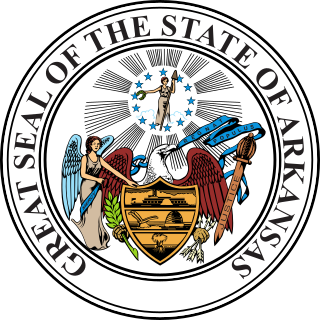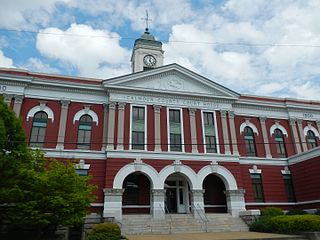
The Alabama gubernatorial election of 1998 was held on 3 November 1998 to select the Governor of Alabama. The election saw incumbent Governor Fob James (R) against Lieutenant Governor Don Siegelman (D). The result saw Don Siegelman win a decisive victory over Fob James. As of 2019, this is the most recent election in which a Democrat was elected Governor of Alabama.

United States gubernatorial elections were held on November 2, 2010 in 37 states and two territories. As in most midterm elections, the party controlling the White House lost ground. Democrats did take five governorships from the Republicans, and Republicans took 11 governorships from the Democrats. An independent won one governorship previously held by a Republican. A Republican won one governorship previously held by an independent. Republicans held a majority of governorships for the first time since before the 2006 elections. One state, Louisiana, had no election for governor, but did feature a special election for lieutenant governor.

The 1962 Alabama gubernatorial election took place on November 6, 1962. Incumbent Democrat John Malcolm Patterson was term limited and could not seek a second consecutive term.

Elections in Alabama are authorized under the Alabama State Constitution, which establishes elections for the state level officers, cabinet, and legislature, and the election of county-level officers, including members of school boards.

The 2014 Alabama gubernatorial election took place on November 4, 2014, to elect the Governor of Alabama.

A general election was held in the U.S. state of Alabama on November 4, 2014. All of Alabama's executive officers were up for election as well as a United States Senate seat, and all of Alabama's seven seats in the United States House of Representatives.

United States gubernatorial elections were held on November 6, 2018 in 36 states and three territories. These elections formed part of the 2018 United States elections. Other coinciding elections were the 2018 United States Senate elections and the 2018 United States House of Representatives elections. The last regular gubernatorial elections for all but three of the states took place in 2014. Governors in New Hampshire and Vermont serve two-year terms, meaning that their most recent gubernatorial elections took place in 2016. Meanwhile, Oregon held a special election in 2016 to fill an unexpired term.

The 2016 Oregon special gubernatorial election took place on November 8, 2016, to elect the Governor of Oregon, concurrently with the 2016 U.S. presidential election, as well as elections for the U.S. Senate and U.S. House of Representatives, and various state and local elections.

A general election was held in the U.S. state of Arkansas on November 6, 2018. All of Arkansas' executive officers will be up for election as well as all of Arkansas' four seats in the United States House of Representatives. Primaries were held on May 22, 2018. Polls will be open from 7:30 AM to 7:30 PM CST.

A general election was held in the U.S. state of Arizona on November 6, 2018. All of Arizona's executive offices were up for election as well as a United States Senate seat and all of Arizona's nine seats in the United States House of Representatives. The Democratic Party picked up three statewide offices, as well as a seat in the U.S. House.

The 2018 Alabama gubernatorial election took place on November 6, 2018, to elect the Governor of Alabama. Incumbent Republican Governor Kay Ivey, who took office on April 10, 2017, upon the resignation of Governor Robert Bentley, ran for election to a full term and won over Tuscaloosa mayor Walt Maddox. Ivey will be sworn into office on January 14, 2019. This is the first gubernatorial election since 2002 in which a Democrat won Tuscaloosa County and the first since 1990 in which neighboring Pickens County voted for a different candidate than Tuscaloosa.

The 1954 Alabama gubernatorial election took place on November 2, 1954, to elect the Governor of Alabama. Incumbent Democrat Gordon Persons was term-limited, and could not seek a second consecutive term.

The 1946 Alabama gubernatorial election took place on November 5, 1946, to elect the Governor of Alabama. Incumbent Democrat Chauncey Sparks was term-limited, and could not seek a second consecutive term.

The 1942 Alabama gubernatorial election took place on November 3, 1942, to elect the Governor of Alabama. Incumbent Democrat Frank M. Dixon was term limited, and could not seek a second consecutive term.

The 1938 Alabama gubernatorial election took place on November 8, 1938, to elect the Governor of Alabama. Democratic incumbent Bibb Graves was term-limited, and could not seek a second consecutive term.

The 1934 Alabama gubernatorial election took place on November 2, 1934, in order to elect the Governor of Alabama. Democratic incumbent Benjamin M. Miller was term-limited, and could not seek a second consecutive term.

The 1930 Alabama gubernatorial election took place on November 4, 1930, in order to elect the Governor of Alabama. Democratic incumbent Bibb Graves was term-limited, and could not seek a second consecutive term.

The 1926 Alabama gubernatorial election took place on November 2, 1926, in order to elect the Governor of Alabama. Democratic incumbent William W. Brandon was term-limited, and could not seek a second consecutive term.

The 1922 Alabama gubernatorial election took place on November 7, 1922, in order to elect the Governor of Alabama. Democratic incumbent Thomas Kilby was term-limited, and could not seek a second consecutive term.

A general election was held in the U.S. state of Alabama on November 6, 2018. All Alabama executive officers were up for election along with all of Alabama's seven seats in the United States House of Representatives. Primary elections took place on June 5, 2018, for both major parties.






















